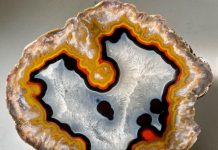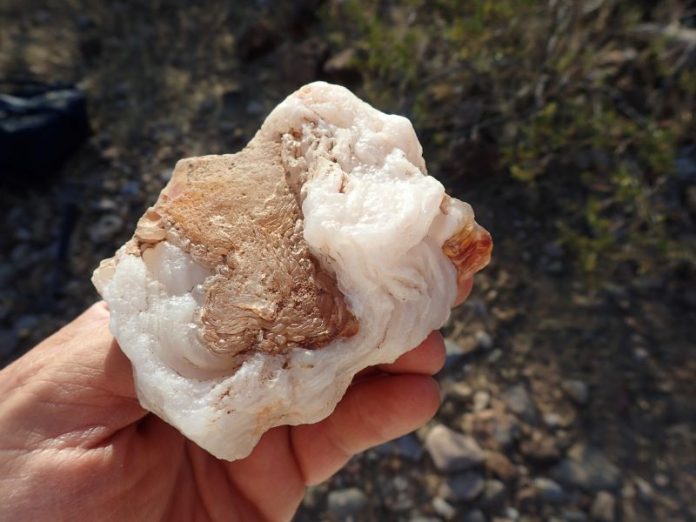
Fire agate is a rare variety of agate and a relatively new gemstone. It was first identified and formally recognized as a gemstone in the 1930s. So far, fire agate has only been found in volcanic rocks of the desert regions of the southwestern United States and central Mexico.
Joy Valley is a remote area in southeastern Arizona that is known for fire agate and chalcedony. The site is in the southeastern tip of Graham County on land administered by the United States Bureau of Land Management (BLM) and on Arizona State Trust Land. Collecting of rocks and minerals is allowed on BLM-administered lands within BLM collecting limits and as long as no one has an active mining claim on the site. Mineral collecting on Arizona State Trust Land is not permitted and entry onto State Trust Lands requires a recreational permit.
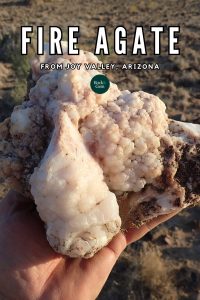
What is Agate?
To understand fire agate, it is important to understand the basics of agate. Agate consists almost entirely of silicon dioxide and sometimes has trace amounts of impurities such as iron and other metals that give it colors or a banded appearance.
Agates are found worldwide in nearly every type of geologic environment and in a wide variety of host rocks. They are typically associated with volcanic rocks, but they can also be found in sedimentary rocks, especially carbonates. While some agates are colorful and have interesting patterns, the vast majority are typically white to gray masses.
They are so common due to the abundance of silicon (Si) in the Earth’s crust. Silicon is never found in its native form in nature. Silicon occurs as its oxide, which is known as silica, and in silicates, such as feldspar and other common rock-forming minerals.
Agates are often described as a microcrystalline or cryptocrystalline form of silica, depending on their texture and internal structure. Microcrystalline minerals are composed of small crystals that can be individually observed with a microscope. Cryptocrystalline substances are made up of such small crystals that a microscope cannot distinguish individual crystals.
Agate Characteristics
Agate is also hard. Since it is comprised of silica, it has a hardness of 7 on the Mohs scale, which is the hardness of quartz. Solid, unfractured masses will be difficult to break with a hammer, but agate with microfractures will sometimes shatter when struck hard.
One of the key characteristics that defines an agate is translucence. If you have a piece that is almost entirely silica, and it is translucent, it can be described as agate. If it is opaque, then it is probably better described as jasper, flint, or chert, which are also microcrystalline forms of silica.
The Greek philosopher and naturalist Theophrastus reportedly made the first agate “discovery” sometime between 300-400 B.C. The discovery was made near Sicily’s Achates River. He named the stone “akhates” which eventually became agate in French circa 1560 A.D. However, some researchers argue that the river itself was named after the stones.
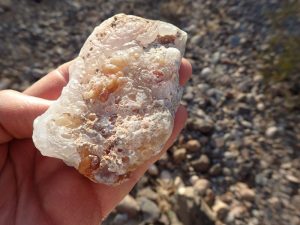
Fire Agate & White Chalcedony
The southwestern United States and Mexico had intense volcanism during the middle and later parts of the Tertiary Period, and the crust underwent extension and uplift. Fire agates formed when hydrothermal fluids, subjected to tremendous temperatures and pressures, became saturated with iron oxides and dissolved minerals leached from the volcanic host rocks. Cracks and voids in the volcanic rocks filled with these hydrothermal fluids, and the fluids were often saturated with dissolved silica. As the rocks cooled, the iron oxides, minerals and silica came out of solution and formed deposits of agate, some of which had the right proportion and conditions of formation to result in fire agates. The formation of fire agate is complex, and the right conditions to form fire agate were rare.
The hydrothermal fluids sometimes did not carry dissolved minerals but were still saturated with silica. These fluids filled the cracks and voids in the host volcanic rock and when the rocks cooled the material was often a white, semi-translucent form of agate known as chalcedony. Much of the chalcedony in volcanic rocks is often white and has a bubbly appearance.
As the crust extended and the mountain ranges uplifted, erosion began to wear away at the rocks. The softer volcanic rocks with fire agate and chalcedony eroded away, leaving the fire agate and chalcedony on the surface. Many of the harder volcanic rocks did not erode and the agates and chalcedony remained in place. Many sources that have fire agate and chalcedony in place have been developed as small surface quarries mined specifically for fire agate. The white chalcedony, while still attractive, is not as valued as the fire agate.
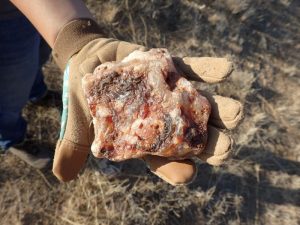
Rockhounding Joy Valley for Fire Agate
The Joy Valley locality is in the Whitlock Valley and west of the Peloncillo Mountains. Agates that weathered out of the volcanic rocks there are likely Quaternary in age.
Joy Valley was once maintained by BLM as a rockhounding location, but the remoteness of the area resulted in BLM abandoning the location because of the cost of maintaining the road to the site and the lack of visitors.
The best landmark for the locality is a yellow cattle guard and a large, weathered wooden entry that says “Ranch” and “Home of Carter Brangus.” The area south of the cattle guard is BLM-administered land, and the area north side of the cattle guard is Arizona State Trust Land. Since the BLM land stops at the cattle guard, this may have been the former BLM rockhounding area.
Collecting minerals is not allowed on Arizona State Trust Land, so the area north of the fence of off-limits to mineral collecting. You must also have a recreational permit to enter State Trust Lands.
While collecting is not allowed, there are no restrictions on walking on the State Trust land and looking at rocks if you have a permit. There is a sign-in book on the north side of the cattle guard on the west side of the road, and many people who signed the sign-in book said they came here for rocks. The sign does not indicate any restrictions on collecting rocks and minerals, so many visitors are likely not aware that collecting is not allowed on Arizona State Trust Land.
Finding Fire Agate
During our visit to Joy Valley, we decided to focus on the area around the cattle guard. Fire agate and chalcedony can be seen on both sides of the wooden entryway and cattle guard. The northern side has much more brush and small arroyos, and you can see both fire agate and chalcedony by walking around and looking for loose rocks. My daughter found a hand-sized piece of fire agate within just a few minutes in this area.
The southern side, which is on BLM land and open to mineral collecting, is much flatter and is a broad plain covered with dark volcanic rocks. You can walk out into this area and look for indications of white and orange among the rocks. White is likely to be chalcedony and orange may indicate a rock with fire agate. I found a large, 10-pound piece of white bubbly chalcedony in this area just by scanning the rocks from a distance.
We found this locality to be an excellent place to find fire agate and white chalcedony. Given the geology of the area, there are likely many more places with fire agate and chalcedony in the volcanic foothills surrounding Joy Valley.
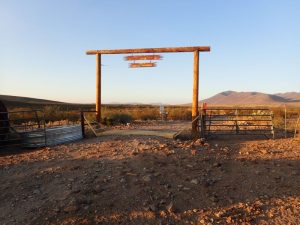
Getting to Joy Valley
The Joy Valley locality is a remote area. Make sure your vehicle is in good shape and that you have plenty of water and other supplies in the event of a breakdown. Compared to many areas in Arizona, the road is relatively good, but some areas are prone to washouts.
To get to the locality, take I-10 to Bowie. From I-10 Business in Bowie, take North Central Avenue 2.0 miles north, and turn right (east) onto Fan Road. Go 2.9 miles and take a slight left onto Donahue Road. Go 1.2 miles, and Donahue Road turns into Fan Road. Continue on Fan Road for 4.1 miles, and then the road turns into North Sand Storm Lane for 3.3 miles. Take a slight right onto east Poppy Ranch Road and go 5.8 miles. Turn left and proceed 3.2 miles to the parking area, which is just south of the cattle guard and wooden entryway.
Although the road looked good, we got a flat tire after we left the site. We went through four rental vehicles total that week. Two lessons here: Always bring a small set of tools, and if you have highway (not off-road) tires, be careful when driving on unpaved surfaces.
The following are GPS coordinates verified on Google Earth:
- Parking area: 32°30’45.7”N 109°15’47.1”W
- Brushy area with fire agate and white chalcedony: 32°30’46.5”N 109°15’47.8”W
- Barren area with white chalcedony: 32°30’44.7”N 109°15’45.9”W
Joy Valley Accessibility
The area is accessible throughout the year, depending on the weather. Thunderstorms and flash floods are a risk during the monsoon season in the middle to late summer, and extreme heat during the summer may preclude visiting. The area is relatively flat and does not have any known open mine shafts or dangerous highwalls, so it is easy to keep an eye on children and dogs when walking around the site.
This story about Joy Valley fire agate previously appeared in Rock & Gem magazine. Click here to subscribe. Story and photos by Robert Beard.


